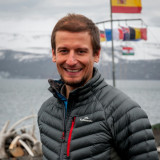Determining Volcanic Rock Porosity Through Reflectance Spectroscopy
Presentation
Authors: Maia Kidd, Gabor Kereszturi, Ben Kennedy, Jonathan Procter
Event: Geosciences 2023 (NZ)
Summary: Using non-destructive VNIR-SWIR reflectance spectroscopy to elaborate determine porosity and uniaxial compressive strength.
Volcanoes are dynamic and complex natural systems, constantly changing through eruptions, alteration, and erosion. They exist as three phase systems, with solids (rock), liquids (circulating fluids), and gases (steam) interact to produce variable physical and chemical interactions. This causes the physical and mechanical properties to be highly heterogenous.
Porosity is one of the most commonly measured physical properties as it provides details on the rocks history and is a first order control on rock strength. Porosity is affected by the original formation conditions (volatile content, crystallinity, cooling rate) and the post-depositional environmental conditions (weathering and hydrothermal alteration). Currently, porosity measurements are completed using a pycnometer and is often destructive, either through crushing to calculate sample volume or drilling a specific sample size. A non-destructive approach would expand the porosity measurement resolution, as each sample could be measured in multiple locations, and provide the ability to measure samples in the field, especially important at sites where collecting samples is prohibited.
Reflectance spectroscopy is sensitive to both physical (surface roughness and crystal/particle size) and chemical (mineral species and abundance) properties of volcanic rocks, and therefore could be used to predict the rocks porosity. This study uses visible-near infrared (VNIR; 350-1000 nm) to shortwave infrared (SWIR; 1000-2500 nm) reflectance data as the input for a Partial Least Squares Regression (PLSR) model to predict porosity. Using training data from a range of volcanoes with varying compositions (basaltic to rhyolitic), porosity (0.02-0.61) and alterations (argillic to fresh). New unseen samples from Ruapehu and Tongariro are tested to assess model accuracy via independent validation (porosity%) and cross validation.
VNIR-SWIR reflectance spectroscopy can elaborate on both porosity and uniaxial compressive strength due to the underlying mineralogy of the training data (e.g., sulfates and phyllosilicates), which can provide a new alternative for non-destructive methods in volcanic systems.

Maia Kidd
PhD Student

Gabor Kereszturi
Earth Scientist

Ben Kennedy
Project Co-Leader: Mitigate